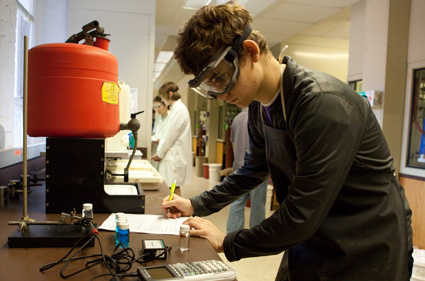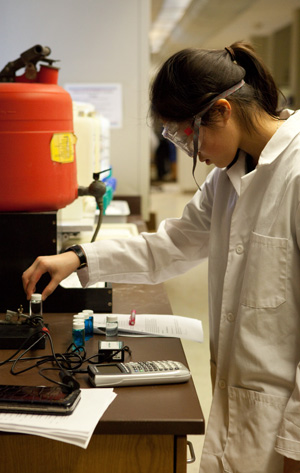Science Olympiad National Tournament Turns K-12 Students' Attention to STEM

Science Olympiad participants at an event during the Illinois Science Olympiad competition.
May 11, 2010
Around 3000 STEM-inclined middle- and high-school students from around the country converged on the Illinois campus May 21–22, 2010 to participate in the National Science Olympiad Tournament (SONT). This was the final competition for the 120 fifteen-student teams who had won their regional and then state tournaments. Illinois, which has hosted the state tournament for 19 years and the national tournament in 2005, is committed to Science Olympiad and its goal of supporting STEM education, with a side benefit of showcasing the Illinois campus. Via both state and national Science Olympiad competitions, participants, who had most likely heard of the University, were able to visit, allowing many campus departments to interact with and recruit these highly sought-after students interested in STEM fields.
What did participants gain? Their main focus, the competition itself, provided participants additional experience in and knowledge about science. Competition events covered a broad range of scientific disciplines from fossils to meteorology to ornithology, and from physics to chemistry to computers. Exposure to the Illinois campus and its myriad opportunities, making new friends, and a raft of fun activities were all icing on the cake. Win or lose, each competitor received a medallion commemorating his/her participation, which will serve as a life-long reminder of this achievement.
What was the SONT experience like? That depended on the participant’s school coach. Some coaches, for whom SONT was a Competition with a capital “C,” arrived with game faces on, cloistering their students in hotel rooms to prepare for the events. Other more enlightened coaches, realizing that meeting fellow participants during social activities is a rich part of the SONT experience and that choosing a good college is a priority, encouraged their young charges to experience all SONT and Illinois had to offer.
Activities. Lest SONT be all work and no play, in addition to informative/educational activities, times for fun, food, and recreation were planned.
- Thursday and Friday. Lecture topics ranged from science to USOs to aliens.
- Thursday, 7:00 pm. A“Dive-In” movie (at CRCE) allowed participants to swim, watch the movie, or both. Swing Dance (complete with lessons) was scheduled for later that evening.
- Friday at noon. A pizza lunch was held at the College of Engineering.
- Friday afternoon. At a Majors Fair held in Area 51 (south of Bardeen Quad), Illinois department/unit representatives manned booths hoping that SONT participants—enticed to visit by tempting give-aways—would stay to listen to their spiel touting the benefits of their department.
- Friday, prior to opening ceremonies. Streetfest—a huge barbecue held west of Memorial Stadium— featured, games, music, and age-appropriate inflatables.
- Friday night at Assembly Hall, 7:30 pm. Swap Meet fostered cross-team interactions as participants visited other teams’ tables to exchange souvenirs they brought to trade.
- Saturday, after competition events end at 3:00 pm. Participants had time to unwind and one last chance to see the campus.
- Saturday, following the awards ceremony. The ARC was reserved for SONT participants.

Illinois student participating in event during Illinois Science Olympiad Competition in April.
Recruitment &scholarships to Illinois.The University is providing incentive for these highly sought-after, STEM-inclined students to matriculate to Illinois. All high school gold medalists from both individual and team events who enroll at Illinois will receive full-tuition scholarships. A similar full tuition waver was offered to gold medalists from the 2005 SONT, whom the University has since been tracking. To date, eight students have graduated from Illinois. Two are “poster children” for Illinois’ full tuition waiver program for SONT gold medalists. One current student is a member of the SONT executive committee. Another gold medalist, Madelyn Kelleher, graduated from Illinois and has started a Science Olympiad team at the Illinois school where she now teaches science.
Regarding recruitment during SONT, over the past year or so, a faculty committee of STEM unit representatives met to give input and strategize on how best to benefit from SONT to recruit these highly-recruited STEM students, a unique opportunity to plug their unit’s programs through tours, open houses, and displays.
Housing and facilities for SONT. According to Howard Guenther, Associate Vice Chancellor for Research, hosting both the state and national competitions in the same year has been a challenge. However, Illinois’ SONT planning team had a few weeks’ window to assess state competition outcomes and implement any changes in the upcoming national competition.
Housing was one of the biggest challenges, according to Guenther. Half of SONT participants stayed in the 2,400 available dorm spaces, while Sherman Hall will house contestants’ families. Most local hotels have been booked well in advance. Guenther finds tackling the job of identifying and assigning Illinois’ great facilities quite rewarding, especially when comparing competitions held here with those held in other states. For instance, while many other venues have held “aviation” events, such as “Wright Stuff” and “Helicopter,” in gymnasiums, necessitating work-around scoring provisions for hitting gym structural obstacles, Illinois’ Armory Building has a large open space with minimal drafts. With its high, domed, uncluttered ceiling, it is unique and perfectly suited for aviation events or those requiring space, such as Trajectory, Pentathalon, and Tow-Line Glider. The new BIF (Business Instructional Facility) will supply numerous event rooms with flat tables, while Illinois’ many labs are perfect for events requiring specific equipment. Assembly Hall can amply accommodate all 3,000 contestants and 3,500 coaches, teachers, chaperones, family, and friends attending the opening and awards ceremonies.

Science Olympiad participant at Illinois lab during Illinois State Competition event.
The SO process of competitions. SONT events are organized by age groups: Division B is for middle school students and Division C is for high school students. For the 2010 SONT, 23 events were required, while each competition also had trial events, 6 at the state and 3 at the national competitions. Each team had 15 students, and the top students were able to participate in as many as three or four events, depending on when they were scheduled.
From January through early March, 15 regional contests were held around Illinois, many in suburban Chicago. Two teams from each region went to the Illinois State Competition. At nationals, a total of 120 teams participated, two from each state (one from each division), while 10 larger states (such as Illinois and California) sent two teams from each division.
Judging. SONT judges were from around the country. Many very experienced state and national directors have judged SONT events for years. To safeguard against home-state bias, each event had two judges, each from different states, with additional helpers. Competition organizers made every effort to prevent conflict-of-interest situations: for instance, one person from Illinois assigned to supervise an event for which her daughter’s team then qualified traded event judging with another supervisor. Further, complicated and detailed event and scoring rules governed each event, and team coaches knew them months ahead of the competition.
New for SONT 2010. For the first time, electronic scoring was used, supported by a web-based application. Also for the first time, Assembly Hall was used for the opening and closing ceremonies. Further, ATLAS, streamed events live on the web, enabling family members at home to watch their child’s event.
Spectator-friendly events. A number of events were designated as “spectator-friendly” and open to spectators. This included events in the Armory, Huff Gymnasium, and the English Building atrium. Others, such as pencil-and-paper tests, were closed.
SONT history. First held by two educators as a local competition in Delaware 26 years ago, Science Olympiad went nationwide two years later. One of these educators, Dr. Gerard Putz, is the current director of Science Olympiad. One of the first states to participate, Illinois has participated for the last 25 years.
More: 6-8 STEM Outreach, 8-12 STEM Outreach, K-12 STEM Outreach, Science Olympiad, STEM Pipeline, 2010













.jpg)
















